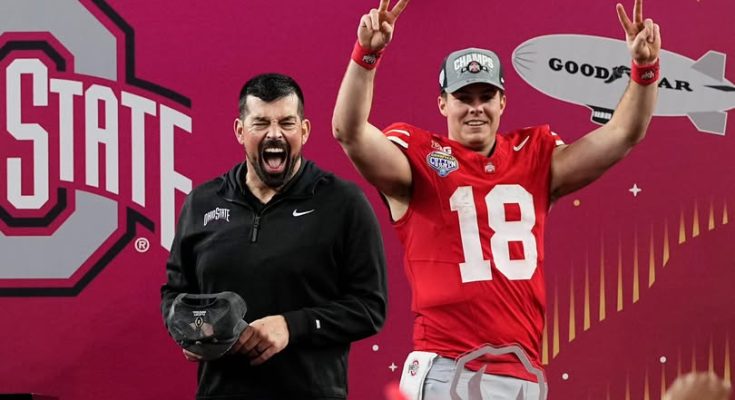Ohio State football is already generating a buzz this offseason, and camp reports are painting a vivid picture of a team that is not only deep with talent but also defined by rising leadership and explosive athleticism. As the Buckeyes prepare for the 2025 season, a combination of emerging stars, key veterans, and high-octane newcomers is setting the stage for a team poised to compete at the highest level. Camp buzz is centered on several pivotal storylines, including Lorenzo Styles securing a starting spot at nickel, Jermaine Mathews emerging as a vocal and strategic leader, and Bryson Rodgers bringing a game-changing dimension to the receiving corps as a WR4 with unmatched speed. Each of these elements underscores a program that thrives on versatility, intensity, and the relentless pursuit of excellence, all while maintaining the disciplined culture that has become synonymous with Ohio State football.
Lorenzo Styles, the son of legendary linebacker Lorenzo Styles Sr., has been turning heads throughout camp with his mastery of the nickel position. The nickel spot, often overlooked by casual fans, is one of the most critical positions in modern college football, particularly in a conference like the Big Ten, where passing offenses are increasingly complex and dynamic. Styles’ ability to read offensive schemes, anticipate routes, and deliver precise, aggressive coverage has made him indispensable in the Buckeyes’ defensive plans. Coaches have praised his football IQ, noting that he not only excels in coverage but also demonstrates an impressive ability to contribute to blitz packages and run support. His combination of physicality, speed, and intelligence allows Ohio State to employ multiple defensive looks without sacrificing cohesion or reliability. The confidence that Styles has garnered through practice and team drills has translated into on-field decisiveness, which will be crucial once the season begins. Observers are noting that Styles’ chemistry with the linebackers and safeties around him provides the defense with fluidity, allowing the unit to adjust seamlessly to various offensive attacks. With Styles securing the nickel spot, Ohio State is positioned to have one of the most versatile and adaptable defenses in the country, capable of defending both spread concepts and power-run schemes with equal efficiency.
Another player making waves this offseason is Jermaine Mathews, whose presence is resonating both on and off the field. Mathews, a seasoned cornerback with a reputation for leadership and accountability, has risen as a central figure in the locker room. His influence is evident in the way younger players approach drills, seek guidance, and absorb strategic nuances during walkthroughs. Coaches have lauded Mathews for his ability to maintain high energy and focus while also serving as a mentor to incoming talent. Leadership at Ohio State is not just about commanding attention; it is about fostering a culture in which players elevate one another. Mathews embodies this principle, consistently providing constructive feedback, motivating teammates during physically grueling practice sessions, and demonstrating the poise necessary to anchor critical defensive moments. His rise as a team leader coincides with the emergence of other defensive talents, creating a cohesive unit that is prepared to execute complex schemes against the top offenses in the nation. Mathews’ influence extends beyond the field as well, as he has become a point of contact for team discussions about discipline, preparation, and mental toughness, all qualities that are essential for a championship-caliber team.
While the spotlight often falls on emerging stars, Ohio State’s depth chart reveals that several key starters are already locked in, providing a solid foundation around which the team can build. On the offensive line, continuity remains a central theme, with veterans returning to anchor positions that are critical for both pass protection and run blocking. Stability in the trenches is particularly valuable given the evolving nature of college football offenses, which increasingly feature hybrid runs, option concepts, and RPOs that require precise coordination and communication between linemen. On the defensive side, linebackers and secondary players who have logged significant playing time provide the backbone for a unit that relies on both discipline and athletic versatility. These locked-in starters allow coaches to focus on development and situational rotations rather than foundational adjustments, a luxury that can significantly impact a team’s readiness for early-season matchups. Veteran presence in key positions also accelerates the growth of younger players, as they can learn directly from teammates who understand the tempo, expectations, and in-game adjustments required at the highest level.
One of the most exciting developments this offseason is the addition of Bryson Rodgers to the receiving corps. Rodgers has quickly established himself as a dynamic WR4, offering a blend of raw speed, route precision, and playmaking ability that adds a new dimension to Ohio State’s offense. In practice, Rodgers has consistently demonstrated the ability to stretch defenses vertically, forcing opponents to account for his speed and opening up opportunities for both intermediate and short passing concepts. His agility and acceleration make him a dangerous threat in open space, and his presence allows the Buckeyes to employ creative formations and motion schemes designed to exploit mismatches. Rodgers’ emergence also provides quarterback C.J. Stroud and the offensive staff with increased flexibility in their game plans, as defenses must now consider the potential for explosive plays on every down. Beyond his athletic gifts, Rodgers has shown an exceptional understanding of timing, leverage, and positioning, traits that allow him to succeed even against tight coverage. His performance in camp drills, scrimmages, and situational exercises signals that he could become a pivotal factor in Ohio State’s passing game, complementing established stars and adding depth to the team’s receiving options.
The integration of these key players—Styles in the nickel, Mathews as a leader, and Rodgers as a game-breaking WR4—reflects a broader theme in Ohio State’s approach to team building. Head coach Ryan Day and his staff have consistently emphasized the importance of blending experience with emerging talent, creating a roster that is both resilient and adaptable. Ohio State’s training camp environment fosters competition, encourages accountability, and rewards performance, allowing players to earn positions based on merit while simultaneously preparing backups to step in seamlessly if injuries or situational adjustments arise. This method ensures that the team remains versatile and prepared for any scenario, a critical advantage in the physically demanding and strategically intricate landscape of Big Ten football.
The strategic deployment of players like Styles and Rodgers also illustrates Ohio State’s commitment to optimizing matchup advantages. In modern football, the ability to tailor personnel packages to specific opponents is paramount. Styles’ proficiency at nickel allows defensive coordinators to counteract spread formations, route-heavy attacks, and dual-threat quarterbacks without compromising run defense. Rodgers’ speed and route versatility, on the other hand, provide the offense with a vertical dimension that can shift the entire field, stretching coverage and creating lanes for complementary athletes. These strategic tools are complemented by the leadership of Mathews and the stability of key starters, providing a cohesive framework within which the coaching staff can implement complex game plans with confidence.
Camp observations have also highlighted the intangible qualities that make Ohio State a perennial contender. Competitive energy, attention to detail, and resilience under pressure are consistently emphasized, and these attributes are increasingly visible in interactions between players and coaching staff. Styles’ ability to anticipate plays, Rodgers’ capacity to make defenders miss in open space, and Mathews’ influence on team morale collectively contribute to a culture where preparation meets opportunity. This environment encourages younger athletes to embrace challenges, learn quickly from mistakes, and elevate their performance through consistent effort and accountability.
As the season approaches, questions about depth, health, and execution remain, but the current camp buzz suggests that Ohio State is not only addressing these areas but also leveraging them as opportunities to strengthen the team. Coaches are focused on fine-tuning mechanics, refining situational awareness, and ensuring that all players understand their roles in a cohesive game plan. Styles’ role as the nickel back, Mathews’ leadership in the secondary, and Rodgers’ dynamic contributions to the receiving corps exemplify how individual excellence can translate into collective success. Observers are noting that these developments are not isolated; they are part of a deliberate and strategic vision designed to maximize talent, foster leadership, and prepare the team for the rigors of a demanding schedule.
Ultimately, the excitement surrounding Ohio State’s camp stems from a blend of proven talent, emerging stars, and high-impact newcomers who collectively redefine expectations for the upcoming season. Lorenzo Styles’ mastery of the nickel position ensures defensive flexibility, Jermaine Mathews’ leadership solidifies team cohesion, key starters provide a foundation of stability, and Bryson Rodgers’ explosive speed adds a new layer of offensive capability. These storylines converge to create a sense of anticipation that goes beyond individual performances, reflecting a program that is both disciplined and dynamic. As the Buckeyes move closer to kickoff, the interplay between experience, leadership, and raw athleticism will be critical in determining not only how the team performs on the field but also how it positions itself among the elite programs in college football. Camp buzz is more than hype; it is a reflection of meticulous preparation, strategic foresight, and the relentless pursuit of excellence that has become the hallmark of Ohio State football. With Styles, Mathews, Rodgers, and the roster as a whole poised to contribute at high levels, the Buckeyes appear ready to combine depth, speed, and leadership into a formidable force, one that could define the trajectory of the 2025 season in the Big Ten and beyond.



